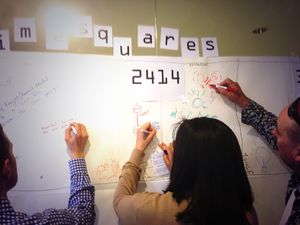Time Squares
| Time Squares | |
|---|---|

| |
| Designer: | David Fono |
| Year: | unknown |
| Players: | 30ish - unlimited |
| Stuff required: | Chart paper, markers, printed cards. |
| Crew required: | One. |
| Preparation: | 10 minutes setup + card printing. |
| Time required: | Unlimited |
| Place required: | A big event |
| Activities: | Writing, drawing, trading |
| This is a playable game - it's finished, tested and ready to play. | |
| This game is made available under an Attribution-Noncommercial Creative Commons licence. (What does this mean?) | |
An ambient game for large events, where time travellers explore different times and spaces of your city while recording their discoveries on an enormous map.
Setup
You’ll need a big wall where you can put up lots of paper (the Time Map). We used 6 pieces of 2x3 chart paper to create a 9x4 drawing surface. This space will be divided into squares/rectangles for different years. In our case, each of the 6 paper pieces represented 1 of 6 years: 2114, 2214, 2414, 2814, 3614 and 5214. Once the paper is up, draw in the year indicators for each area, and draw a basic map of your city with major landmarks/features.
You’ll also need a bunch of markers to leave near the wall, for people to draw/write with.
Gameplay
Everybody playing gets a single card to start. Cards are double-sided, with the generic introduction/rules on one side, and the details of that particular card on the other side. Each card is either a Year Card or a Discovery Card. When you have a Year Card, you are told the year you’re in and the format of something to add to the map. You then need to trade this with another player for a certain kind of Discovery Card. The Discovery Card tells you the kind (i.e. inspiration) of the thing you should add to the map. Then you, you go add to the map with the assigned format and inspiration. Finally, you trade your Discovery Card with another player for a certain kind of Year Card, and the process repeats.
The theoretical goal is to make it to all the years, but this may be impossible/boring/meaningless compared to the basic activity of adding wacky stuff to the map.
Getting Started
This is an ambient game, and the game is explained entirely on the individual cards, so to get started you just need to get the cards in circulation. There are 48 cards in the deck, and each card is only tradable with certain other cards, so you should only start the game once you can give out a significant portion of the cards. If there are lots of people who might play, you can print additional decks and bring them into circulation as the game progresses.
Cards
If you want editable versions of these, you can get the PSDs here: https://www.dropbox.com/sh/bt83fjk0z1oo9be/XT61FFKPJR
- Instructions
- Year Cards 1
- Year Cards 2
- Year Cards 3
- Discovery Cards 1
- Discovery Cards 2
- Discovery Cards 3
Inspiration
Map drawing from Trap Street and card trading from The Man Who Was Thursday.
Playtest Notes and Possible Improvements
- There was no pacing built into the game aside from card trading, which could happen relatively quickly with most players in the same spot. This meant that there were lots of people writing/drawing at once, which created a bottleneck.
- Interest seemed to wane quickly; people only made a couple of contributions before falling away. The queue in front of the map may have contributed to this. It’s also possible that this is a quality common to events where people mingle and drink; there’s an established pattern of behaviour at these events, and while people may deviate from them for short periods, the natural tendency is to drift back without any external influence. It might be worth designing to this tendency; perhaps the game is played by fewer people at a time, but lasts a short amount of time before being passed on to another group.
- There didn’t appear to be much thought put into making items on the map work together; players just whipped up a (often silly) idea and slapped it down. Again, silly, fast creativity may be more suited to an event where lots of other activity is occurring than thoughtful, collaborative creativity. Similarly, the stakes are probably just not high enough to encourage real effort. Greater collaboration might be possible in a different context, where the game is a focal point rather than a diversion.
Play History
Time Squares was played at Pecha Kucha Toronto on April 1, 2014.
<flickr size="m">ludocity%3Agame%3Dtimesquares</flickr>
(These are the ten most recent Flickr photos of Time Squares. To add your own, just add the "ludocity:game=timesquares" tag to your Flickr photos.)
